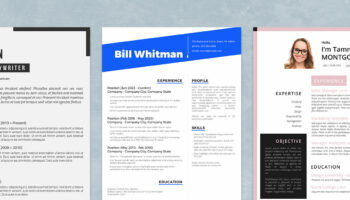Gaps in employment are not fatal, but they can muddle that first impression you make to a potential employer. Indeed, the last thing you want is to get branded as ‘unreliable’ or ‘job hopper’ aka someone who cannot hold on to a good job for too long. While you certainly cannot re-write your career history, there are several ways to put a positive spin on those gaps in your resume.
How Employers React to Gaps in Employment
The popular lore says that gaps in a resume are almost always viewed as an absolute deal-breaker by prestigious employers.
But let’s put things into perspective for a second. Plenty of talented and highly successful people took sabbaticals and some 15% of employers even have formalized paid and non-paid sabbatical policies. Then there are working parents who chose to leave their career for a while to focus on the family.
Watch our HR tips to tackle employment gaps in this short video:
Plus, some other very valid reasons can stand behind the employment gaps on a resume such as:
- Personal health or medical issue
- Providing care for a child or another family member
- Pursuing further education or changing careers
- Taking time off to relocate to another city/state/country
- Taking a personal leave (sabbatical) to volunteer, travel, or work on a personal project
- Recuperating after being laid off
- Working as a freelancer/contractor
All of these reasons are hardly uncommon and most won’t put off potential employers as much as you may imagine. Yes, applicants with gaps in employment may have a lower chance of landing a job interview when compared to candidates with an uninterrupted employment track record. However, applicants who addressed their employment gaps in the resume are more likely to be called to the interview.

The takeaway – don’t leave the recruiter wondering about your gaps. Instead, provide a forthcoming and honest explanation of your situation both in your resume and cover letter.
How to Explain Gaps in Employment: 4 Strategies
Here’s the deal: when it comes to applying for a new job, most employers will be more interested in your most recent work experience, training, and achievements. So if your employment gap happened some 3 to 5 job positions earlier, you can confidently leave it out and focus on highlighting your most recent accomplishments.
Explaining gaps in employment that have a fresher date is a bit more challenging, but still doable. Below are several quick strategies that will help you make those gaps look like a tiny decorative perforation on your resume, rather than a glaring, attention-sucking hole.
1. Conceal Short-Term Gaps Within the Role You Had at That Time
For example, you fell ill and had to take a medical leave for six months in 2016 and then returned to work for the same company. If that’s the case, you can format the respective job entry in the following manner:
June 2016-December 2018
Event Coordinator at The International Peace Federation
As a head events coordinator, I was responsible for organizing semi-annual events that were attended by corporate executives, philanthropists, and A-List celebrities.
In this case, you bridge a gap in your resume without actually mentioning that you were off work.
2. Omit the Employment Months and Leave Years Only
Alternatively, if you have a ‘meaty’ Work Experience section, spanning over a decade, you can conceal small gaps in your resume (under 12 months), by leaving out the exact employment dates and months.
For example, you can choose to format your entries in the following manner.
March 2019-Present
Senior Product Manager at Company X
2017-2019
IT Project Manager at Company Y
2015-2017
Junior Project Manager at Company Z
2014-2015
Scrum Master at Startup W
Such an approach is somewhat less favorable as it may leave some recruiters wondering about the omission of months unless they get ‘sold’ on your core competencies and accomplishments listed for each role.
And as we already mentioned, it’s always better to honestly talk about your career progression.
3. Leave a Quick Note, Explaining Your Gap
Most recruiters are guilty of skimming resumes before reading them properly. So when they see a gap and no explanation, they might make certain assumptions that will not play in your favor.
To avoid that you can try the following: incorporate your gap within one of the roles. Here’s how it can look:
March 2018-June 2020
UX Designer at Tech Company
UX/UI designer, specializing in designing user interfaces for SaaS products and financial applications. Top Behance designer of April 2019. Took a family leave between June 2019 and April 2020. At that time, I have also obtained new certifications in UX writing and completed a workshop on Information Architecture.
4. Use a Functional Resume Format
If neither of the options really work for you or you have more than one employment gap that you’d rather not highlight, try a functional resume format.
Unlike the traditional chronological resume format the encourages you to list all the work entries one after another, a functional resume emphasizes your overall qualifications, transferable skills, and first-hand experiences without linking them to specific work entry.
This resume format is less preferable among HRs, but it can help you get your foot into the door if you’ve been out of the workforce for a while.
Learn more about the different resume formats in this video:
To ‘pull off’ a functional resume, you need to:
- Write a strong resume objective statement
- Provide a detailed resume summary
- Create a solid list of skills that match the employer’s requirements
- Complement your resume with a compelling cover letter.
What If I Had a Long-Term Sickness?
When you are talking about an extended period of sickness that lasts longer than a year, this can be a little more difficult to address in your resume. Where you may not feel completely comfortable about disclosing the nature of your malady, you can simply state that you were taking some long-term leave for medical reasons. It would then be up to the employer to enquire further should they wish to know more.
If the illness you suffered is unlikely to affect your work performance in your new role, then you can tell your potential new employer this without actually disclosing the nature of your illness. However, if you know that you have an ongoing medical condition, you should inform your employer and make them aware of any special working requirements or adjustments you need to have put in place.
In any case, prepare a short explanatory statement that you’ll share with the employer during the interview.
To Conclude
At the end of the day, the best approach to addressing gaps in employment is being honest and confident. Most employers can understand your decision to stay at home with the kids or take a break for another reason. Pretty much every employer will appreciate the fact that you took some time off to pursue further education, training, or licensing.
Remember, your main goal is to merely communicate the reasons why you chose to leave the workforce. You don’t need to provide excuses or over-justify your decision.
Last updated on December 2020






